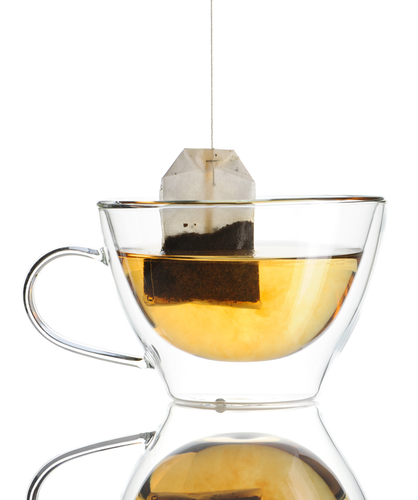 Written by Dr. Mercola from Mercola.com
Written by Dr. Mercola from Mercola.com
Raising questions about the safety of plastic tea bags
I’ve long advocated drinking tea in lieu of coffee, but the downside of modern food technology is again rearing its ugly head and causing brand new health concerns over this otherwise healthful brew.
A recent article in The Atlantic raises questions about the safety of plastic tea bags, some of which have fancy pyramid shapes, designed to allow the tea leaves to unfurl during infusion.
 Chances are you’ve never even given the tea bag a second thought. But indeed, some of the newer tea bags are made with a variety of plastics; some are nylon, some are made of viscose rayon, and others are made of thermoplastic, PVC or polypropylene.
Chances are you’ve never even given the tea bag a second thought. But indeed, some of the newer tea bags are made with a variety of plastics; some are nylon, some are made of viscose rayon, and others are made of thermoplastic, PVC or polypropylene.
Anyone aware of the dangers of plastic chemicals leaching out of plastic containers and bottles is likely to be concerned about drinking tea steeped through heated plastic.
The other bad news is that paper tea bags may be just as bad, or worse, than the plastic ones because many of them are treated with epichlorohydrin, a compound mainly used in the production of epoxy resins.
Considered a potential carcinogen by the National Institute for Occupational Safety and Health (NIOSH), epichlorohydrin is also used as a pesticide. Besides making its way into tea bags, it can also be found in coffee filters, water filters, and sausage casings.
When epichlorohydrin comes in contact with water, it hydrolyzes to 3-MCPD, which has been shown to cause cancer in animals. It’s also been implicated in infertility (it has a spermatoxic effect in male rats) and suppressed immune function.
This chemical is already a well-known “process contaminant” associated with modern food production. According to the American Oil Chemicals Society5 (AOCS), 3-MCPD can also be found in variable levels in refined vegetable oils, which is yet another reason to avoid such cooking oils and replace them with organic coconut oil.
Do Plastic Tea Bags Pose a Health Concern?
As you probably know, chemicals in plastic containers and bottles have been found to leach into food and drink, thereby posing a number of health hazards. Examples include bisphenol-A (BPA), bisphenol-S (BPS), and phthalates, all of which mimic hormones and act as potent endocrine disruptors.
Unfortunately, according to the featured article, neither the Center for Health, Environment, and Justice nor the Centers for Disease Control and Prevention (CDC) have any information on the toxicity of plastic tea bags or the levels of plastic chemicals that might migrate into the tea when steeped in hot water. Hard to believe, but true, the US federal agencies are not supervising this potential toxic exposure.
According to the featured article:
“Could plastic tea bags also be bad for our health? They are most commonly made from food grade nylon or polyethylene terephthalate (PET), which are two of the safest plastics on the scale of harmful leaching potential.
Both have very high melting points, which offer some assurance to consumers, as one would think the melting point of plastic is the temperature at which one would need to worry about accidentally eating it.
There is another temperature point for plastics, though, that we may need to worry about, called the ‘glass transition’ temperature (Tg). That is the temperature at which the molecule in certain materials such as polymers begin to break down. As a rule, the Tgof a material is always lower than the melting point.”
Water boils at 212 degrees Fahrenheit (100 degrees Celsius). In the case of PET the glass transition point (Tg) is about 169 degrees, and the breakdown point of nylon is even lower than PET.
“If the question is, ‘As the polymer goes through that transition state, is it easier for something to leach out?’ ‘the answer is yes,’ said Dr. Ray Fernando, professor and director of polymers and coatings at Cal Poly San Luis Obispo,” The Atlantic states.
So while these plastics are generally considered among the safest in terms of leaching potential, the molecules in these plastic tea bags may still in fact break down and leach out when steeped in boiling water—which is the recommended way to brew a good cup of tea, especially when you’re using higher quality whole tea leaves, which these newer tea bags are designed for…
lindsay
June 5, 2014 at 8:49 am
Really interesting, thanks for sharing.
Pingback: Why "Clean Coal" is an Oxymoron | Care2 Healthy Living
Pingback: 11 Reasons You Shouldn't Believe in "Clean Coal" - myEARTH360 (the blog)